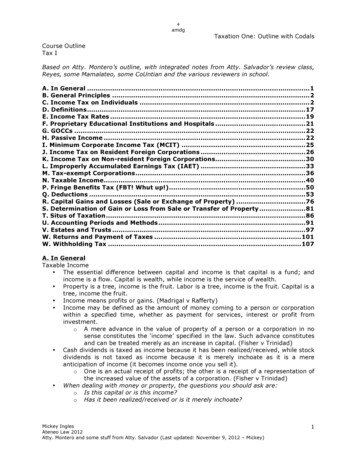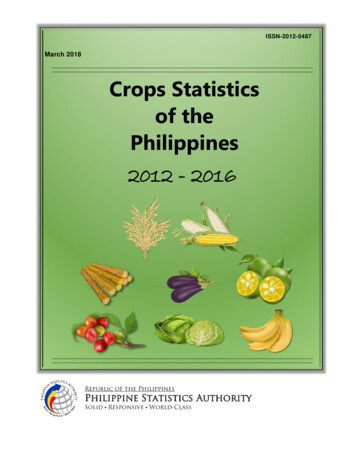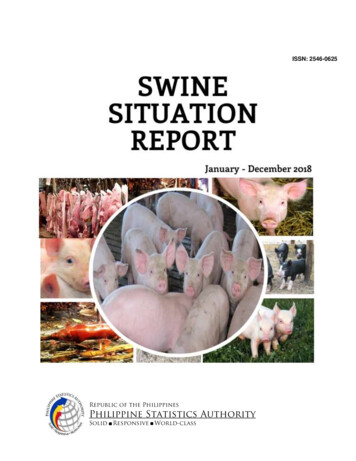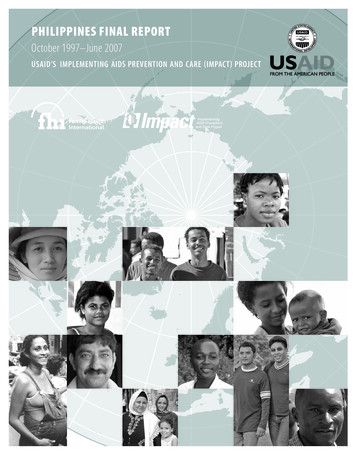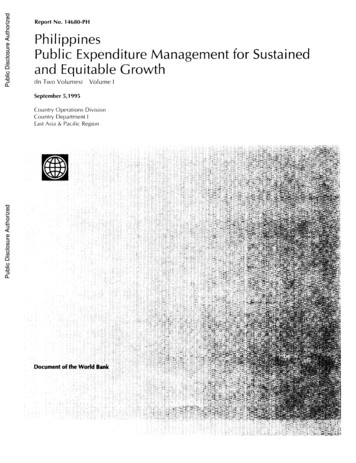
Transcription
Public Disclosure AuthorizedReport No. 14680-PHPhilippinesPublic ExpenditureManagement for Sustainedand Equitable Growth(In Two Volumes)Volumne ICountry Operations DivisionCountry Department IEastAsia & Pacific RegionPublic Disclosure AuthorizedPublic Disclosure AuthorizedPublic Disclosure AuthorizedSeptember5,1995-O-4JWari.44?z %.T'ssI Z-
This report has been prepared by Hisan Shishido (task manager). Major contributors were:, Douglas Hartle,Jeffrey Hammer, David Steedman, Stephen Howes, John Arnold, Antoine Schwartz, Syed Husain, RosarioManasan, Pierre Markowski and Domenico Fanizza. Anjum Altaf, Shaikh Hossain, Renee Santiago, RenciePadernal, Benjamin Diokno, and Soniya Carvalho also contributed. Nam Pham prepared statistical appendix. Peer reviewers were Homi Kharas and Malcolm Holmes. Deep appreciation goes to Bob Killoran whohas patiently put this report together. Charu Vasil and Harry Travis provided editorial assistance.
.
PHILIPPINESPublic Expenditures Management forSustained and Equitable GrowthTable of ContentsPage No.Executive Summary .Introduction .i.I1. A REVIEW OF FISCAI AGGREGATES .3National Goverment .3Consolidation of the Public Sector .9Government Owned and Controlled Corporations .112. THE GOVERNMENT'S ROLE AND RESOURCE ALLOCATION ISSUES . 16Introduction .16Determinants and Effects of Aggregate Expenditure Pattems .Efficiency and the Role of the Public Sector in the Economy . 16. 18Equity in Public Expenditure .21Omissions .25Policy Recommendations on Sector Expenditure .26TRANSPORT SECTOR.26POWER SECTOR.28WATER SUPPLY .31AGRICULTURE AND NATURAL RESOURCES .32EDUCATION .35HEALTH AND NUTRllION .38
3. DEVOLUTION AND LOCAL GOVERNMENTS .41Background and Rationale .41Issues - Unintended and Intended Consequences of Devolution .43Principles for Improvements .51Policy Direction and Recommendations .524. CIVIL SERVICE REFORM.55Introduction .55Background Analysis .55(a) Size, Salaries and Cost .55(b) Management Issues .57(c) Reform Initiatives .59Rationale and Objectives.60(a) Rationale.60(b) Objectives.63Strategic Issues .63(a) Political Commitment and Institutional Arrangements .64(b) Streamlining .64(c) Salary Strategies .65(d) Ways of Changing the Civil Service Size and Skills Mix . 66(e) Personnel Management .S. BUDGET PLANNING AND MANAGEMENT .6869The Formal Budgetary Cycle .69Recent Budgetary Initiatives: Palliative or Cure? .73Issues74.Policy Recommendations .75
ANNEX TO CHAPTER 5RECOGNITION AND MANAGEMENT OF CONTINGENT AND OTHER LIABILITIES . 82Introduction .82Definitions .83Management and Control of Contingent Liabilities .83(a) Objectives .(b) Budget and Expenditure Management Process .83.84(c) Valuation .85(d) Tuning of Expenditure Recognition .86(e) Minimizing Losses .86Management and Control of Actuarially Determined Liabilities .87(a) Objectives .87(b) Budget and Expenditure Management Process .87Accountability .88Conclusion .88ATTACHMENT (Definitions).90LIST OF TABLES. CHARTS AND BOXESCHAPTERlTABLES1-I Fiscal Aggregates 1980-94 (Percent of GNP) .1-2 Trends in Public Expenditure in Asian Countries (As a Percentage of GDP) .4.41-3 National GovermmentO&M Spending by Selected Sector (% of GNP) . .71-4 Budgetary Inflexibilities -Mandated Expenditures (Percent of GNP) . .81-5 Programmed and Actual Revenues and NG Investment (Billion) . . 91-6 Public Investment By Sector (% of GNP) .10
11.11-7 Consolidated Public Sector Deficit (billion peso, and % of GNP) .1-8 Total Internal Cash Generation of Major GOCCs (In Million) . .12121-9 Net Income of Major GOCCs (Million) .1-10 GOCC - National Government Financial Flows (Cash Basis) . 141-11 NPC: Net Financial Flow with the National Government (In Million).161-12 National Government Accounts - Medium Term Projections(Percent of GNP) (Including CB-BOL) .18CHARTS1-1 Public Expenditures 1976-1994 .1-2 Mandated and Productive Expenditures .57CHAPTER 2I&DLFs2-1 Determiinantsof Total Expenditure by Functional Category 1975-1993. 17CHARTS2-1 Distribution of Taxes and Expenditure by Regional Income . 222-2a Potential Incidence of Public Housing Program .242-2b Substandard Housing by Regional Income .24CHAPTER3TAfLE3-1 Net Transfers to LGUs (Nominal million pesos) .453-2 Consolidated Expenditures of National and Local Governments: Selected Items (% of GNP) . 453-3 Sectoral Allocation of National and Local Government Expenditures (% of GNP) . 463-4 Expenditures by Sector, All Local Government Units: 1991, 1993 (% of GNP) . 483-5 Collection Rates of Real Prperty Tax (percent) .493-6 Total, Social and Health Expenditures Per Capita by LGUs 1991 and 1993, in nominal pesos . 50
BOXES1 Civil Service Reform in Individual Agencies: the Case of the Central Bank . .592 An Audit of DECS .3 Competent Bureaucracies and Rapid Economic Growth .61. 62
CURRZENCYEQ-UlIVALENr(as of June 1995)Currency Unit Peso ()US 1 25.581 US 0.039FTISCAI,YEARJanuary 1 - December 31ABBREVIATIONS AND ACRONYMSAA - Advice of AllotmentABM - Agency Budget MatrixADB - Asian Development BankARB - Agrarian Reform BeneficiaryARC - Agrarian Reform CommunitiesARF - Agrarian Reform FundARO - Allotment Release OrderATO - Air Transport OfficeBESF- Budget of Expenditures and Sources ofFinancingBLT- Build, Lease and TransferBOI - Bureau of InvestmentsBOT - Build-Operate-TransferBSP - Bangko Sentral ng Pilipinas (Central Bank)BWSA- Barangay Water Supply AssociationCAG - Corporate Affairs Group (in Department ofFinance)CALABARZON- Cavite, Laguna, Batangas, Rizal,QuezonCAR - Cordillera Autonomous RegionCARL - Comprehensive Agrarian Reform LawCARP - Comprehensive Agrarian Reform ProgramCB-BOL- Central Bank - Bureau of LiquidationCCPAP - Coordinating Council of the PhilippineAssistance ProgramCOA - Commission On AuditCS - Civil ServiceCSC - Civil Service CommissionCSPD - Consolidated Public Sector DeficitDA - Department of AgricultureDAR - Department of Agrarian ReformDBM- Department of Budget and ManagementDECS- Department of Education, Culture and SportsDILG - Department of Interior and LocalGovernmentDOE - Department of EnergyDOF - Department of FinanceDOH - Department of HealthDOST-PCIERD- Department of Science andTechnologyDOTC - Department of Transport andCommunicationDPWH - Department of Public Works and HighwaysDSWD - Department of Social Welfare andDevelopmentEMK - Effective Maintenance KilometerEO - Executive OrderEPZ - Export Processing ZonesERB - Energy Regulatory BoardESC - Education Service ContractFAP- Foreign Assistecl ProjectsFAPE- Fund For Assistance to Private EducationGAA - General Appropriations ActGARO - General Allotment Release OrderGASTPE- Government Assistance to Students andTeachers in Private EducationGDP - Gross Domestic ProductGFI- Government Financial Institutions
GNP - Gross National ProductNEDA - National Economic and DevelopmentGOCC - Government Owned and ControlledCorporationsAuthorityNFA - National Food AuthorityGOP - Government of the PhilippinesNG - National GovernmentGPEP - Grains Productivity Enhancement ProgramGSIS- Government Service Insurance SystemNHA - National Housing AuthorityNIA - National Irrigation AdministrationNIS - National Irrigation SystemHYV- High Yielding VarietyNMYC - National Manpower and Youth CouncilIA - Irrigators AssociationNPC - National Power CorporationNWRB - National Water Resource BoardIADP - Integrated Area Development ProjectICG - Internal Cash GenerationO&M - Operation and MaintenanceIPP - Independent Power ProducersIRA- Internal Revenue AllotmentODA - Official Development AssistanceOECF - Overseas Economic Cooperation FundISF - Irrigation Service FeeOPSF - Oil Price Stabilization FundKPA - Key Production AreasPAL - Philippine Air LinesLGU - Local Government UnitsPCGG - Presidential Commission For GoodGovernmentLPG - Liquefied Petroleum GasLRTA - Light Rail Transit AuthorityPD - Presidential DecreePDO - Port District OfficesLWUA- Local Water Utilities AdministrationPMO - Port Management OfficesPNOC - Philippine National Oil CompanyPNR - Philippine National RailwaysPPA - Philippine Port AuthorityMIAA - Manila International Airport AuthorityMICT - Manila International Container TerminalMMTC - Metro Manila Transit CorporationMOOE - Maintenance and Other OperatingRA - Republic ActExpendituresMTADP - Medium Term Agricultural DevelopmentPlanMTPIP - Medium Term Public Investment ProgramSARO - Special Allotment Release OrderSEF - Special Education FundSSL2- Salary Standardization Law IIMW - MegawattsSSS - Social Security SystemsMWSS- Metropolitan Waterworks and SewerageSystemSUC - State Universities and CollegesSWIP - Small Water Impounding ProjectNAIA - Ninoy Aquino International AirportNALGU - National Assistance to Local GovernmentNCA - Notice of Cash AllocationNCEE - National College Entrance ExaminationTFS - Tuition Fee SupplementsNCR - National Capital RegionWD - Water DistrictNEA - National Electrification AdministrationNEAT - National Educational Achievement TestWFP - Work and Financial PlanVAT- Value Added Tax
EXECUTIVESUMMARYPHILIPPINESPublic Expenditure Management forSustained and Equitable GrowthThis report discusses howpublic expenditure managementcan be further improved in thePhilippines, focusing on fourareas:(i) the role of the public sector inthe environment of theexpanding private sector;(ii) fiscal devolution and roles ofthe national and local governments;(iii) building acivil servicethat canmaginagechangingGovernment role;Fiscal management remainspotentially precarious. Raisingadditional tax revenues hasbecome increasingly difficultwhereas past under-spending ininfrastructure and social sectorshas enormously increased theexpenditure needs in these sectors.Fiscal balance was restored in 1994mostly because of higherprivatization proceeds, lowerdomestic interestrates and lowerThierearethusurgenitneedsto public investmentffiat efficien)cycanthaneinhaon)ceoffiscolthan rymaniugermienttThe findings of this reportoutline a framework for managingpublic expenditures in the Philippines to achieve sustained andequitable growth. While recommendations are discussed in moredetail below, this framework canbe briefly summarized:* Rationalize expenditures thathave not sufficiently achievedobjectives. Examples includeNFA consumer subsidies and agood portion of spending on stateSocialuniversitiessafety nets andneedcolleges.betterpighar, the hightargeting.Tax expenditures,which amountto some 30privatizationbillion, need to be reviewedproceeds, arebased on clear priorities.andUdifficultto sustain.and)betterThere are thus(iv) betterThere are thusbudgetary management thaturgent needs to enhance efficiencyidentifies and ensures funding of fiscal management by prioritizof priority activities, anding expenditures and improvingincorporates contingent andbudgetary management. The veryactuarial liabilities within thenature of national governmentfiscal framework.expenditure patterns is changing,TIheGovernment of the Philiphowever, due to the evolving rolepines has been successfullyof the public sector as the privateimplementing liberalizationsector role expands; and devolumeasures and increasing the roletion which is changing the relativeof the private sector in theshare of responsibilities betweeneconomy. These efforts have, bythe national and local govern1994,contributed to regainingments. Improving public expendimacroeconomic balance andture efficiencyalso requiresrestoring income growth based on examining who manages theprivate investments and exports.public sector (the quality of theSustaining robust economiccivil service) and how publicgrowth rates and addressing theresources are managed (budgetarycountry's development needs,processes) in addition to wherehowever, will require significantresources go.public as well as private investment.# Improve budget procedures forbetter fiscal forecasting andcontrol. It is vital that amedium-term fiscal frameworkwith improved projections offiscal aggregates be used as abasis for budget planning, andthat agreement with Congressbe reached on this frameworkso that agreed priorities can beimplemented. It is also criticalthat the cost of contingentliabilities, particularly forgovernment guarantees, beincorporated.* Strengthenfiscal devolutiont rough increasing autonomygnacntability foreoagovernments. Local governments need full autonomy Inneed to be made accountableand face hard budget con-PopI
EXECUTstraints. Local governmenttransfers can be improved bytaking into account equityconsiderations and providingincentives to implementprojects that have high externalities (particularly in thesocial or environmental areas).Much needs to be done tostrengthen local governmentcapacity to carry out theseroles.* Focus on improving civilservice quality and efficiency.As the role of the governmentchanges, needs for the civilservice change: from directprovider of services to facilitator for efficient private activities. It is important thatgovernment be staffed by anable and professional cadrethat can carry out this role.Civil service reform thatimproves inter alia incentivesfor higher level and professional staff - improving overallefficiency - is an importantplank of overall fiscal reform.THE ROLE OF TH EGOVERNMENTThe public sector still has asignificant role to play despite theexpanding role of the privatesector into areas previouslyconsidered the monopoly of thepublic sector. The simple groundrule is that the Government needsto intervene either as a serviceprovider or regulator when anefficient market solution is unlikely to exist if left to the privatesector or when the equity impactis significant.Some services that used to beprovided only by the public sectorcan now be provided by thePup2IVESprivate sector competitively. Thishas been made possible throughtechnical development anddecomposing what used to beconsidered a natural monopolyinto a number of contestableactivities. The most notableexample is that the power sectorhas been unbundled into generation, transmission, and distribution. The Build-Operate-Transfer(BOT)arrangements with privatepower generators were instrumental in overcoming the recentpower crisis. Other examplesinclude toll roads, telecommunication and water plants. Furthermore, part of government servicessuch as road maintenance andrefuse collection can be contractedout to the private sector.The Government, however, isaware that the private participation is not a panacea for thegovernment's fiscal problem in allsectors. The private sector"cherry picks" - investing primarily where returns are high andthe pay-back period is short. Theymaximize the financial returnrather than the return to thesociety in general. This mayincrease the cost of servicessignificantly. The Government'sregulatory oversight is thusimportant especially whereprivate participants face limited(or no) competition; regulation ofprices or service levels is requiredIt is also the responsibility of thegovernment that the privatelyprovided portion of the servicenetwork (transport, power transmission, water supply) should beeffectively integrated in theoverall network.Finally,public service provisionneeds to complement privateactivities and not to substitute forUMMARYthem. This distinction can besubtle in the social sectors. Publicprovision of curative health(which can be provided by theprivate sector) increases theoverall services in poorer regionsbut not in the richer regions. Inthe latter, public provision merelycrowds out private services. Acareful review is needed not onlywhat services should be providedby the Government but also wherethese services are provided forequity reasons. Similarly,theGovernment efforts to achieveuniversal secondary education bysubsidizing those with no publicschool access to go to privateschools has reduced the supply oftrue private schools, and created aclass of hybrid schools which callthemselves private but are dependent on the government subsidies.These subsidies have also divertedresources from important primaryschools.RElArlIVEROLES OFNATIONAL AND l.OCAl(G\VERNMEN rISIn 1992,the National Government started the process ofdevolving major fiscal responsibilities for health, agriculturalextension, forest and watershedmanagement, rural infrastructureand some welfare programs tolocal government units (LGUs),while increasing resource transfers. The objectives include: toimprove local service delivery, andto reduce perception of politicalalienation outside the MetroManila through increased localautonomy.It is too early to judge the trueconsequences of devolution asdata are limited, but a number of
EXECUTobservations can still be made.First the allocation of transfers toindividual LGUs is not based onthe LGUs' fiscal needs, fiscaleffort, fiscal capacity or theamount of devolved responsibilities. Thus there are winners andlosers in terms of financial resources, without significantcorrelation to economic or socialattributes of individual LGUs.Second because there is noincentive for LGUs to raise morerevenues or implement activitiesimportarntfor the nation as awhole, local revenue efforts areweakening and problems areoccurring in implementingprojects (both foreign assisted andlocally funded) whose benefitsspill over to more than onejurisdiction. Third LGUs arespending larger amounts in thesocial sectors, but spending oneconomic services (irrigation,roads, etc.) appears to be suffering. The National Government'swillingness to continue to fundthese devolved functions seems tobe a crucial reason for the LGUs'reluctance to allocate their ownresources. Fourth. becausedevolution makes fiscal monitoring of the consolidated publicsector more difficult, the LGUsneed to confront strict budgetconstraints so that the overallbudget discipline be kept. Finally.an early indication is that thedevolution may be increasinginequity; this needs to be monitored and steps taken to deal withthe problems.Recomumendations.Severalsteps could be taken to improvethe functioning of the existingsystem:IVES* make LGUs accountable andharden the budget constraints within which theymust operate by removinguncertainties (both amountand timing) on transfers tothem, stopping NG funding ofdevolved activities, monitoring LGU borrowing, andresisting pressures for nationalgovernment bail-out of LGUsin debt service difficulties.* strengthen LGU capacity forfiscal planning and implementation especially to ensurethat LGU budget systems arecoordinated with nationalsystems; there is a clear rolefor the national overnment inforovidingtechnical assistancehere. develop a good statisticalbase for deriving the amountof transfers to each LGU,especially in the area ofpopulation.While the current system ofincome transfers is working - andthere would be some politicaldifficulties in adjusting it - theGovernment may at some timewish to modify it. Two potentialimprovements are highlightedhere:* incorporateconcerns aboutequity and local resourcemobilization in the allocationmechanism of resourcetransfer by considering anequalization grant based onthe tax base and revenueefforts. provide incentives for funding critical activities for asmall number of selectedUMMARYareas, by allowing costsharing with the nationalgovernment.CIVIll SERVICE, REFORMThe ongoing evolution of thepublic sector due toprivatization and devolutionprovides a unique opportunityfor carefully redefining its rolesand priorities, and accordinglyidentifying ways to improvepublic sector management.The Government has seizedthis opportunity and started ac ivil service reform processcalled streamlining the bureaugThe goal of this exerciseto improve efficiency of thecentral bureaucracy which, byGoversrnent'sfown admission,suffers from "structural andsystemic dysfunction".Objectives. dhere are five keyobjectives for civil servicereobjciem frcvl-evca) redefine the role of the publicsector and the civil servicefollowed by the restructuringand reorganization of departments and agencies;b) identify and reconfigure asrequired the civil service skillsmix;c) improve incentives to attractand maintain desired skills;d) establish controls over the sizeand cost of the public service;ande) develop an integrated systembuanagng personnelforbudgets, pOsitions andindividuals.In order to implement effectivecivil service reform, the Government needs to design an integrated reform strategy thatincorporates all five objectivesPop93
EXECUToutlined above. The presentreform effort falls short in establishing the desired skill profile,improving incentives and installing a system of personnel management. These aspects are crucial,because the civil service is increasingly expected to be a catalyst foran economic transformation, andthe composition and quality of thefuture civil service should besuited to this new role.Recommendations To achievethe objectives discussed above, thereform strategy must integrate theneeds for: clear definition ofpublic sector roles; identificationof the skills mix and organizational structure required forcarrying out the defined roles;transparent and fair implementation of restructuring and reorganizing; appropriate incentives toachieve the desired skills mix; anda reform in personnel management with a view to reinforcingand sustaining these improvements. While the Government ismaking efforts to form thisstrategy, the following actionswould contribute to the success ofits implementation:a) Strong political commitmentfrom the highest level ofleadership is required, and theOffice of the President needsto take an increased lead inthis process. The existingPresidential Committeeresponsible for the exerciseand its Technical Secretariatmay be reinforced by theaddition of representativesfrom CSCand advised byoutside experts as necessary.b) A reform of the incentivesystem. based on a detailedPop4IVEScosting of the various options,would help achieve andmaintain the desired skillsmix, which will probablyinclude a higher proportion ofprofessional staff. Such areform would allow higherlevel civil servants to beremunerated at rates morecompatible with their privatesector counterparts. At lowerlevels, salaries are relativelycompetitive with the privatesector. A move away from theexisting policy of concentrating wage increases at lowerlevels would be highlydesirable.c) A combination of voluntaretirement and targetedretrenchment of surplus staffwould complement the reformof the incentive system inachieving the desired skillsmix. This approach would befar superior to reliance onlyon natural attrition.d) Personnel managemenreform, based on a review ofthe current allocation ofmanagement tasks amongmentralagencies, wouldsignificantly contribute to theimproved functioning of thecivil service. Managementwould also benefit from animproved common humanresources data base and asystem of objective performance evaluation.e) In the restructuring the publicsector organization, it isimportant that the Govemment provide GOCCs andcertain regulatory agencieswith more autonomy regard-UMMARYing recruitment and wagestructures.BUDGEIARY PROCESSESThe budget processes are at leastpartly responsible for the inadequate coordination betweendevelopment planning and projectand program implementation; forthe selection of some low priorityprojects over higher priorityprojects; for inordinate delays inimplementing high priorityprojects; and for a bias againstadequate maintenance of existingfacilities with a consequentdecline in public services.Issues There needs to be anoverall agreement on the fiscalframework and national prioritiesamong members of the Congress,central departments of the Executive, and line departments because, especially in a democracy,the budget process entails thereconciliation and compromises ofa multitude of conflicting interests. The central departments(DBM,NEDA, DOF) usually takea lead in preparing the budgetproposal. The Congress thenimposes different priorities byadding activities of its own choice(often in the areas of local roadsand irrigation, and state collegesand universities). The Congresshas to delete some other activitiesbecause by constitution it cannotincrease the peso amount of thebudget. The congressionaldeletion often includes foreignassisted projects.The Executive (DBM) oftencounters Congressional amendments by rationing cash in such away as to favor the activities towhich it accords highest priority.
EXECUTRevenue shortfalls relative to theestimates used in the budget are agood reason to limit cash releases,but the threat of shortfalls (andnot the actual shortfalls) is enoughfor the Executive to introduce andmaintain cash rationing during afiscal year. Furthermore, conflicts can often exist between thepriorities assigned to projects bythe central agencies and thepriorities favored by the linedepartments. Because cashreleases are in essence fungiblebetween projects within a samedepartment/agency, the lineagencies could also alter thespending priority thus subvertingthe prionties established by thePresidentCash rationing also has theeffect of delaying implementationof high priority projects becauseline departments face greatuncertainty concerning the flow offunds that will be forthcoming.Given the uncertainty, someagencies try to safeguard theirmonth by month cash allocationsfor the payment of wages andsalaries first before they start tospend on more discretionarybudget items.Finally, there are technicalproblems in project preparationproject appraisals are oftenjeopardized due to the insufficienttra
E X E C U T I V E S U M M A R Y PHILIPPINES Public Expenditure Management for Sustained and Equitable Growth This report discusses how Fiscal management remains The findings of this report public expenditure management potentially precarious. Raising outline a framework for managing

